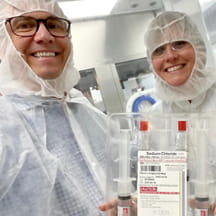Children’s hospitals across the country started to see a potential shortage in albuterol in the summer of 2022. As the two existing manufacturers of albuterol in the U.S. had to pause production, there was an uptick in off-season respiratory syncytial virus (RSV), flu and COVID-19 that created a perfect storm for a drug shortage when it was needed most.
“There was a lack of output across the board,” says Mark Spiecker, president of STAQ Pharma, a 503B outsourcing facility that provides compounded pediatric medication.
While albuterol is an essential drug for children suffering from a reactive airway disease like asthma, certain formulations are primarily used in specific patient populations. A particular formulation of continuous albuterol was identified as one of the initial 32 pediatric essential drugs, making it crucial to ensure a stable supply.
As the shortage persisted, STAQ was able to help supply—and maintain—continuous albuterol for children’s hospitals. “Although there were no commercial suppliers that were able to make it, as an outsourcing facility, we were in a position to step in,” says Spiecker.
Albuterol shortage solutions
Children’s hospitals and members reached out to Children’s Hospital Association (CHA) to raise the concern of a potential shortage. This prompted a period of information gathering with CHA, convening a group of hospitals and suppliers to learn more about the shortage, its cause, and best mitigation strategies.
“We worked with members to find out what kind of finished product they were looking for,” says Terri Lyle Wilson, pharmacy services director at CHA. “Did they want it to be 5 mL? 20 mL? What kind of container will work best? We wanted to ensure that whatever was released in the marketplace was safe and effective.”
Other forms of albuterol existed, but administering smaller and less concentrated formulations can require more than 40 doses and several hours of work. Eventually, all presentations of nebulized albuterol ran dry after covering gaps in the supply chain. Additionally, more time spent administering medicine proves difficult in a time when respiratory therapists and pharmacy staff are in short supply.
With a clearer understanding of members’ needs, CHA and STAQ worked together to secure the active pharmaceutical ingredients (APIs) for albuterol. Once the product arrived in the U.S. in late 2022, CHA connected with the Food and Drug Administration to ensure the supply quickly made it through U.S. Customs. With the product now available, STAQ began manufacturing the drug in slip tip syringes to ensure safety and applicability for children’s hospitals.
Replenishing albuterol supply
STAQ has started production of the first batches of albuterol for children’s hospitals across the country. Since the organization is a new producer, the first batches have tight, 32-day expiration dates. With it taking a few weeks to release and deliver the product, the albuterol is set to expire roughly 15-18 days after the hospitals receive them. That makes it paramount to deliver the product on time and requires weekly deliveries with coordination from both STAQ and the hospitals.
STAQ makes redundant batches in case there are any production or delivery issues. “We have backups,” says Spiecker. “We will continue to supply it. We want to get the hospitals through the respiratory season.”
Maintaining albuterol supply
As the product proves to be safe and stable, the expiration dates will slowly lengthen, with 60-day expiration dates in March, 90 days in April and 180 days by July 2023. This will allow for the supply to stabilize for providers.
“STAQ plans to ramp up to full production by May 2023 so that hospitals have a stable supply ahead of the next respiratory season,” says Spiecker.
This effort is an example of CHA’s commitment to ending drug shortages through collaborations across teams, hospitals, government agencies and industry partners like STAQ. “We were able to get into the private sector and work on behalf of our members to support them,” says Wilson. “Our partnership makes all of our work more effective.”




